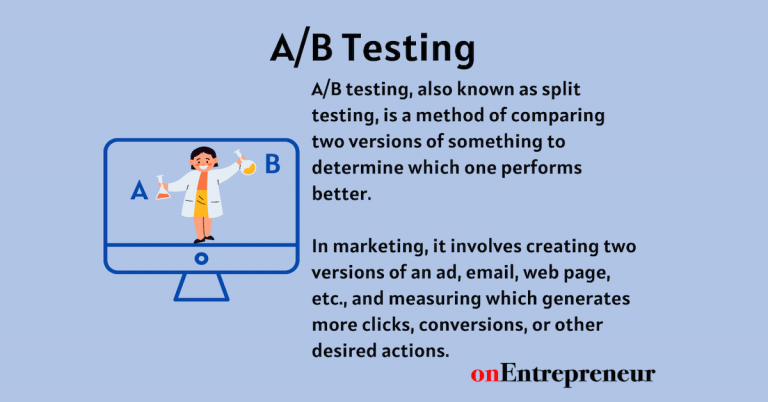A/B testing, also known as split testing, is a method used in marketing and advertising to determine which version of an ad, email, web page, or other marketing material is most effective. It involves creating two (or more) versions and measuring which one performs better based on key metrics.
Why Use A/B Testing?
A/B testing provides data-driven insights to help optimize marketing assets. It removes some of the guesswork involved in determining what resonates best with target audiences. Marketers use A/B testing to:
- Test hypotheses about what will work
- Continuously improve performance
- Allocate budget to better-performing assets
How to Implement A/B Testing
Follow these steps to successfully execute A/B tests:
- Define goals and metrics. Determine what you want to test and how you’ll measure success (click-through rate, conversions, etc.).
- Set a budget. Decide how much traffic to drive to each version to get statistically significant data.
- Choose what to test. Aspects like headlines, images, calls-to-action, layouts, etc.
- Determine when to test. Consider timing and seasonality when planning tests.
- Create variations. Make incremental changes between versions to isolate the impact.
- Analyze the results thoroughly. Look at all metrics segmented by audience, time period, and other factors.
- Implement the winning version. Roll out the better-performing version going forward.
The Power of Iterative Testing
The key is to continually test and refine based on the results. Audiences and contexts change over time. Ongoing A/B testing provides the feedback needed to optimize marketing effectiveness.
A/B testing takes some upfront planning but pays dividends through data-backed decision-making. Leveraging this methodology can lead to significant improvements in marketing performance over time.
Example of A/B Testing
Here is a demo example of how A/B testing could work for an e-commerce website:
1. The Scenario:
An online retailer wants to improve conversion rates for its product pages. They decide to test tweaking the call-to-action (CTA) button against the original version.
2. Setting Up the Test:
The current CTA on product pages is an orange button that says “Add to Cart”. Using an A/B testing tool, they create a variant page with a blue button that says “Buy Now”.
3. The Testing Period:
They drive an equal number of visits to the original page (A) and variant page (B) over a 1-week period. The testing tool tracks clicks on the CTA button.
Analyzing Results:
- Original CTA (A): 1,500 visits, 275 clicks, 18.3% CTR
- Variant CTA (B): 1,500 visits, 329 clicks, 21.9% CTR
The new CTA generated a 3.6% increase in click-through rate. Since the only change was the button text and color, the test isolated the impact of this variable.
Next Steps: Because the new “Buy Now” CTA performed better, they will launch this button text and design across all product pages moving forward. But they will continue testing other elements like images, copy, etc. to find additional improvements.
FAQs
What is A/B testing?
A/B testing, also known as split testing, is a method of comparing two versions of something to determine which one performs better. In marketing, it involves creating two versions of an ad, email, web page, etc., and measuring which generates more clicks, conversions, or other desired actions.
Why should I use A/B testing?
A/B testing provides data-driven insights to help you optimize marketing assets for better performance. It enables you to test ideas and find out what resonates most with your target audience. Ongoing A/B testing can lead to significant improvements over time.
How do I set up an A/B test?
First, decide what you want to test and define success metrics. Create two distinct versions, controlling variables to isolate the impact of your test. Send equal traffic to each version and analyze differences in metrics like click-through rate. The version that meets your goals better is the winner.
How long should an A/B test run?
Run tests long enough to collect statistically significant data, which depends on your traffic levels. For high-traffic websites, a week may suffice. Less traffic may require a couple of weeks or more. Keep a close eye on conversion rates as the test runs.
How many variations should I test?
Start with just two options—an original (A) and a variant (B)—to simplify analysis. You can run sequential tests with additional variants over time. Too many concurrent options make it hard to interpret what’s driving an impact.
What tools can I use?
Many email marketing, ad platforms, and analytics tools have built-in A/B testing capabilities. You can also use dedicated split testing tools like Optimizely, VWO, or Google Optimize.



